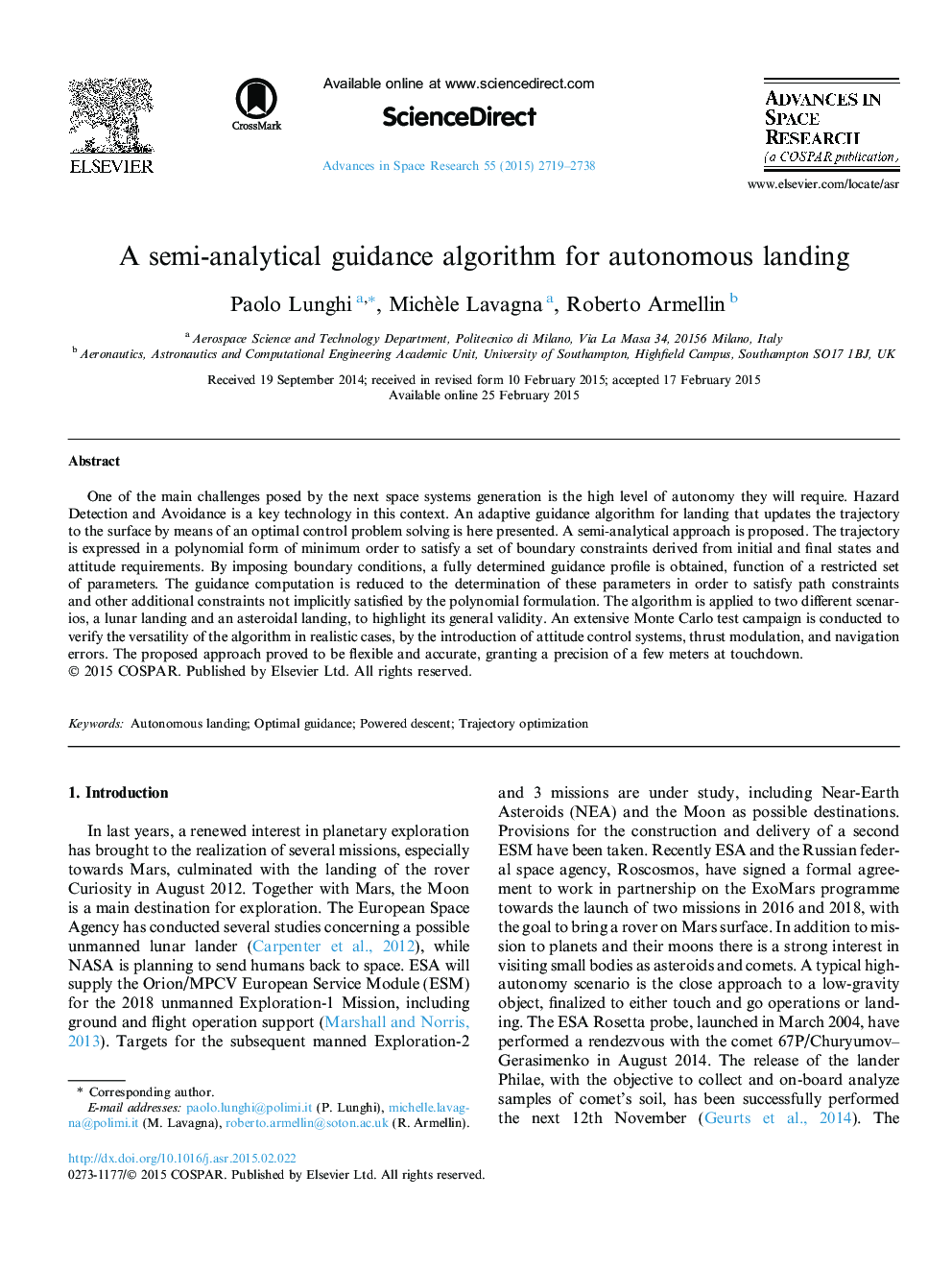| کد مقاله | کد نشریه | سال انتشار | مقاله انگلیسی | نسخه تمام متن |
|---|---|---|---|---|
| 1763416 | 1020001 | 2015 | 20 صفحه PDF | دانلود رایگان |
عنوان انگلیسی مقاله ISI
A semi-analytical guidance algorithm for autonomous landing
ترجمه فارسی عنوان
الگوریتم هدایت نیمه تحلیلی برای فرود مستقل
دانلود مقاله + سفارش ترجمه
دانلود مقاله ISI انگلیسی
رایگان برای ایرانیان
کلمات کلیدی
فرود مستقل، راهنمایی بهینه، فرود زمینی، بهینه سازی مسیر،
ترجمه چکیده
یکی از چالش های اصلی مطرح شده در نسل بعدی سیستم های فضایی، سطح بالایی از استقلال آنها است که نیاز به آن دارند. تشخیص و پیشگیری از خطر یک تکنولوژی کلیدی در این زمینه است. الگوریتم هدایت انطباقی برای فرود که مسیر را به سطح با استفاده از حل مسئله کنترل بهینه به روز می کند، ارائه شده است. روش نیمه تحلیلی پیشنهاد شده است. مسیر در یک فرم چندجمله ای از حداقل الگوریتم برای برآورده شدن مجموعه ای از محدودیت های مرزی که مشتق شده از شرایط اولیه و نهایی و شرایط نگرش بیان می شود، بیان می شود. با اعمال شرایط مرزی، یک نمایه راهنمایی کاملا مشخص شده به دست می آید، عملکرد یک مجموعه محدود از پارامترها. محاسبات ریاضی به تعیین این پارامتر ها محدود می شود تا محدودیت های مسیر و سایر محدودیت های اضافی را که به طور ضمنی توسط فرمول چند جمله ای رضایتبخش نباشد، برآورده شود. الگوریتم به دو سناریو متفاوت، فرود فرود قمر و فرود سیارک اعمال می شود تا اعتبار عمومی آن را برجسته سازد. یک کمپین آزمایش گسترده مونت کارلو برای تأیید تطبیق الگوریتم در موارد واقع بینانه با معرفی سیستم های کنترل نگرش، مدولاسیون رانندگی و خطاهای ناوبری انجام شده است. رویکرد پیشنهادی انعطاف پذیر و دقیق بوده و دقت چند متر را در زمین لرزه در نظر گرفته است.
موضوعات مرتبط
مهندسی و علوم پایه
علوم زمین و سیارات
علوم فضا و نجوم
چکیده انگلیسی
One of the main challenges posed by the next space systems generation is the high level of autonomy they will require. Hazard Detection and Avoidance is a key technology in this context. An adaptive guidance algorithm for landing that updates the trajectory to the surface by means of an optimal control problem solving is here presented. A semi-analytical approach is proposed. The trajectory is expressed in a polynomial form of minimum order to satisfy a set of boundary constraints derived from initial and final states and attitude requirements. By imposing boundary conditions, a fully determined guidance profile is obtained, function of a restricted set of parameters. The guidance computation is reduced to the determination of these parameters in order to satisfy path constraints and other additional constraints not implicitly satisfied by the polynomial formulation. The algorithm is applied to two different scenarios, a lunar landing and an asteroidal landing, to highlight its general validity. An extensive Monte Carlo test campaign is conducted to verify the versatility of the algorithm in realistic cases, by the introduction of attitude control systems, thrust modulation, and navigation errors. The proposed approach proved to be flexible and accurate, granting a precision of a few meters at touchdown.
ناشر
Database: Elsevier - ScienceDirect (ساینس دایرکت)
Journal: Advances in Space Research - Volume 55, Issue 11, 1 June 2015, Pages 2719-2738
Journal: Advances in Space Research - Volume 55, Issue 11, 1 June 2015, Pages 2719-2738
نویسندگان
Paolo Lunghi, Michèle Lavagna, Roberto Armellin,
